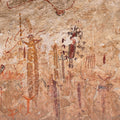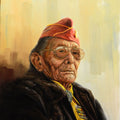'Migrant Mother' and more, Dorothea Lange photographs at Eiteljorg Museum
By Medicine Man Gallery on

Dorothea Lange, Resettlement Administration photographer, in California, 1936. Farm Security Administration-Office of War Information Photograph Collection (Library of Congress)
Consider it the Mona Lisa of photography. Perhaps not the greatest picture ever taken – although undeniably powerful – but the most recognizable.
Dorothea Lange’s Migrant Mother has appeared in countless textbooks and on a U.S. postage stamp. No one recalls where they first saw the picture, it seems programmed into the factory settings of the American mental image vault.
Taken in 1936 at a migrant-worker camp in Nipomo, CA, the image distilled human suffering on a national scale into the despairing face of one woman. The Great Depression in a single image.
This picture wasn’t worth a thousand words, more importantly, it was worth millions of dollars. The photograph’s wide publication, which began days after it was taken, raised political awareness to the dire need for immediate federal assistance around the country and helped convince Congress to provide it. Migrant Mother fed people. It resulted in housing.
More than 80 years later, it also remains a prized attraction at art museums with its latest feature coming at the Eiteljorg Museum of American Indians and Western Art in Indianapolis during “Changing Views: The Photography of Dorothea Lange.” The show features 30 oversized prints of Lange’s (1895-1965) remarkable black-and-white photography from the 1930s and 40s, including Migrant Mother, Nipomo, California, along with the work of other documentary photographers from the Depression Era and four contemporary photographers creating images in the spirit of Lange.
“I think the most powerful thing about (Migrant Mother, Nipomo, California) is the way that the mother is protecting her children with her body and presence, while she also clearly is worrying about what she will do in the future,” Jessica Nelson, the Eiteljorg’s director of religion and culture initiatives who curated the traveling exhibition locally, said. “Many people have experienced that dual burden in a crisis, of having to keep putting one foot in front of the other while also wondering how long we’re going to be able to keep going, and it’s that tension that makes the image so compelling.”
The subject’s older children literally and figuratively lean on their mother for everything. Between them and her affecting gaze, you may miss the baby she supports in her lap. Bad weather had destroyed the pea crop and her family was on the brink of starvation.
Don’t confuse Migrant Mother with simply a case of being in the right place at the right time. Scenes like this repeated themselves across the country, but only Lange was able to capture it this succinctly. The picture is a masterwork of composition, an exquisite example of artistic, documentary photography.
As the legend goes, Lange drove past the camp initially, but something told her to turn around.
“It’s ironic in some ways that Migrant Mother has become the quintessential Lange photograph because the circumstances were different from most of Lange’s work,” Nelson explains. “Lange was returning from a road trip and simply stopped for about 20 minutes at the pea pickers’ camp where Florence Thompson was staying and took seven photographs. Usually, Lange spent several hours talking with the people she was photographing.”

Dorothea Lange (1895-1965), Migrant Mother, Nipomo, California, 1936. Gelatin silver print, 32 x 26 inches (framed); art2art Circulating Exhibitions
Florence Thompson
Florence Thompson. She was the migrant mother.
That wouldn’t become known until 1978 when Thompson sent a letter to the editor at the Modesto Bee newspaper, “outing” herself as Mother. She was upset by inaccuracies shared about her circumstances following the picture’s capture and how, despite its global fame, she didn’t benefit a dime from it.
“Lange typically took detailed field notes – and did take some notes for Migrant Mother – (but) she didn’t always record the names of the people she photographed,” Nelson explains of Mother’s long anonymous subject. “I think the expectations surrounding documentary photography and record-keeping were just different in the 1930s than they are today.”
Florence Owens Thompson was born in Indian Territory in 1903. Full blooded Cherokee. She migrated from what became Oklahoma to California looking for work along with thousands of other “Okies.”
She was 32-years-old when Lange’s photograph was taken although she could easily have passed for 42. Life was obviously not easy for her. Still, look closely, and her beauty is revealed. Dust-blown, weary and dressed in rags, had she been born to different circumstances, she might be the prettiest woman in town.
Hardship and deprivation can be seen in Thompson’s face, but resolute strength and dignity as well.
Dorothea Lange
Committed to social justice, Lange used her camera to bring out the humanity of and create empathy for ordinary people struggling with poverty, unemployment, homelessness and dislocation. “Changing Views” features many more of Lange’s images made during her time as a traveling documentary photographer for federal government agencies during the New Deal and World War II.
“Documentary photography itself was a fairly new field, and Lange was part of the first cohort of photographers to really focus on documenting rural America,” Nelson said. “Among the other photographers hired by the Farm Security Administration, Lange’s work stands out for the way her photographs highlight the human cost of the Great Depression.”
This ability was likely the result of her years as a studio portrait photographer in San Francisco. That’s how she supported herself, her family, and her then-husband Maynard Dixon. She was hired by the Farm Security Administration the same year that she divorced Dixon.
“The framing and composition of her photos was exceptional, but I do think it was her empathy and ability to extrapolate emotion from a scene that really differentiated her photography from others,” Nelson said.
Following World War II, Lange became the first woman photographer awarded a Guggenheim fellowship and was honored by the Museum of Modern Art with a career retrospective.
Her influence can clearly be seen in the exhibition’s contemporary photographers.
“All of the contemporary photographers have embraced Lange’s philosophy of showcasing the dignity and resilience of the people that they photograph,” Nelson said. “I think they’ve advanced this legacy even further by seeing the people they photograph as co-creators of the image. The contemporary photographers’ goal is to share images of humans that reflect how those individuals want to be seen by the world.”
“Changing Views: The Photography of Dorothea Lange” can be seen at the Eiteljorg through August 6, 2023.




